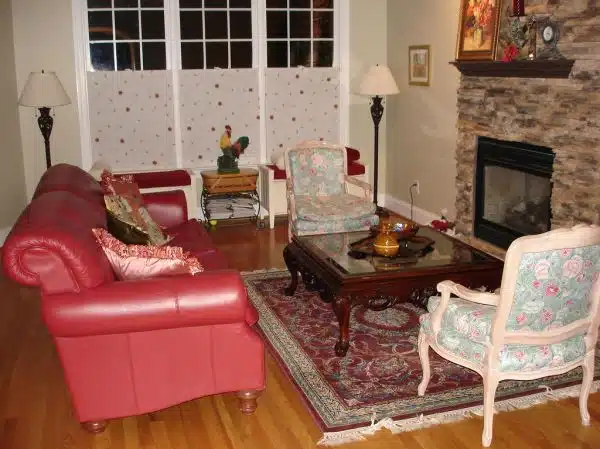The living room is the heart of any home, where families come together to relax, entertain and spend time with each other. A key element in creating the right atmosphere for your living room is the lighting scheme, which can be achieved through a combination of different lamps. Choosing the right lamps can transform your living room into a warm, inviting space that reflects your personal style and enhances the overall ambiance of your home.
When selecting lamps for your living room, there are several factors to consider. The size and layout of the room, as well as its décor and overall theme, should all play a role in determining which lamps will work best. Additionally, you must also take into account practical considerations such as brightness levels, color temperature, and energy-efficient options. In this article, we will explore some key tips and guidelines to help you choose the perfect lamps for your living room that will create a welcoming space that meets your needs and preferences.
The Importance Of Lighting In Your Living Room
Lighting design plays a vital role in enhancing the overall aesthetic appeal of your living room. Not only does it add to the decor, but it also plays a significant role in creating the perfect ambiance for any occasion. Proper lighting can be used to set different moods and tones that are suitable for various activities such as reading, entertaining guests, or watching movies.
Mood setting is an integral aspect of lighting design for your living room. It refers to using light to create a particular mood or atmosphere that complements the activity you are engaging in. For instance, if you want to read a book, you will need bright task lighting that is directed towards your reading material. On the other hand, low-level ambient lighting is ideal for intimate conversations or relaxing after a long day at work.
Incorporating a combination of different types of lamps can help achieve an optimal balance between functionality and aesthetics in your living room. Understanding how each type works and what they offer will enable you to choose lamps that best suit your needs and preferences. This guide will help you understand the different types of lamps available and how they can be used to enhance the look and feel of your living room.
Understanding Different Types Of Lamps
When it comes to choosing the right lamp for your living room, there are a variety of options available. Understanding different types of lamps can help you make an informed decision that suits your style and lighting needs. Here are some common types of lamps:
- Floor lamps: These tall lamps stand on the floor and are great for adding ambient lighting to a space. They come in many styles and materials, from sleek modern designs to traditional brass finishes.
- Table lamps: These versatile lamps can add both task lighting and ambient light to a room. They come in various shapes and sizes and can be placed on any flat surface such as a side table or console table.
- Pendant lights: These hanging lights provide both functional and decorative lighting. They come in various styles, including simple glass globes or ornate chandeliers.
When considering the type of lampshade material, there are several options available, including silk, linen, cotton, paper, metal or glass. Each material offers its own unique look and feel. Silk is perfect for providing a luxurious feel while linen provides a more casual look. Metal shades offer an industrial feel while glass shades provide an elegant touch.
Another aspect to consider when selecting lamps is bulb brightness options. Different bulbs offer varying levels of brightness that suit different activities such as reading or watching television. It’s important to keep in mind that higher wattage bulbs produce brighter light but also consume more energy.
Choosing the right lamp size for your space is crucial for achieving optimal lighting levels in your living room. In the next section we will discuss how to choose the appropriate size based on various factors such as ceiling height and furniture placement.
Choosing The Right Lamp Size For Your Space
Have you ever seen a small lamp in a large room? It resembles a lone soldier standing in the battlefield, lost and outnumbered. On the other hand, an oversized lamp in a small room is like a giant that takes up all the space. Choosing the right size of your lamps is crucial to achieve balance and harmony in your living room.
When picking lamp styles, consider the height of your ceilings and furniture. A general rule is to have the bottom of the shade at eye level when seated. If your ceiling is low, opt for shorter lamps with wider shades to spread light horizontally rather than vertically. Conversely, if you have high ceilings, taller lamps will help fill up the vertical space.
Sizing lampshades appropriately is also essential for aesthetics and functionality. A shade that’s too big can overwhelm the base and look disproportionate while one that’s too small can create harsh lighting that’s uncomfortable to the eyes. Use this table as a guide when choosing lampshade sizes:
| Lamp Height | Recommended Shade Size |
|---|---|
| 18-20″ | 8-10″ |
| 24-26″ | 12-14″ |
| 28-30″ | 14-16″ |
| 32-34″ | 16-18″ |
By following these guidelines, you’ll be able to pick lamps that complement your living room’s style while providing adequate lighting for different activities such as reading or socializing.
Moving forward, matching lamps to your room’s decor involves more than just picking colors and patterns that match your furniture. In the next section, we’ll explore how different lamp styles can enhance or transform your living room ambiance without breaking the bank.
Matching Lamps To Your Room’s Decor
After choosing the right size of lamps for your living room, it’s time to focus on matching them to your room’s decor. One important aspect to consider is mixing patterns. If you have patterned furniture or curtains, make sure to choose a lamp with a solid color shade to balance out the space. On the other hand, if your furniture and decor are more neutral, adding a lamp with a fun patterned shade can add visual interest and personality.
Another crucial element in lamp selection is color coordination. While it’s not necessary for every piece in the room to match perfectly, it’s essential to pick lamps that complement other colors in the space. Consider the existing color palette of your room and choose lamps with shades that either blend seamlessly or provide contrast. For example, if your walls are painted a soft blue, a lamp with a white shade will create an airy feel while one with a deep navy shade will add depth.
When it comes to incorporating different lighting levels into your living room design, table lamps are an excellent addition. They offer both function and style while creating ambiance in any space. Layering different types of lighting sources such as floor lamps and overhead fixtures can also add dimensionality to your living room design. Remember that each light source should work together harmoniously rather than compete for attention. By thoughtfully selecting lamps that complement each other and fit within your overall decor scheme, you’ll be able to create a cohesive look that elevates your living room into a beautiful and functional space.
Incorporating Different Lighting Levels
Layering lighting is essential to creating the perfect ambiance in your living room. Not only does it provide functionality, but it also adds an element of visual interest. A well-lit space can make a room feel larger, brighter and more welcoming. To achieve this, consider using a variety of light sources such as ceiling fixtures, floor lamps and table lamps.
Mixing lamp styles is another way to create visual interest while layering lighting. Using lamps of different heights, textures and materials creates depth and dimension to your space. For example, a tall floor lamp paired with a small table lamp can add balance and symmetry to the room. Additionally, choosing lamps with unique shapes or colors can serve as a focal point in the space.
When selecting lamps for your living room, it’s important to take into consideration the functions of each area within the room. For instance, you may want brighter lighting near reading areas while dimmer lighting may be more appropriate for movie-watching areas. By incorporating different levels of lighting throughout the space, you can create an atmosphere that suits your needs while adding style and interest to your design.
With proper layering and mixing of lamp styles, you can elevate your living room’s design by adding depth and interest through various forms of illumination. However, don’t forget about using accent lamps for visual interest – which we’ll discuss next!
Using Accent Lamps For Visual Interest
Accent lamps are a great way to add visual interest to your living room. They can be used to highlight specific areas or objects in the room, and can create a warm and inviting atmosphere. When choosing accent lamps, it is important to consider the overall design of the space and how the lamps will fit into it.
Mixing textures is an effective way to create depth and interest in any room. When selecting accent lamps, consider using different textures such as metal, wood, or glass. This will add visual interest to the space and create a layered effect.
Layering lighting levels is another important consideration when choosing accent lamps. By using different types of lighting at varying levels, you can create depth and dimension in the room. Consider using table lamps, floor lamps, and wall sconces to create a layered look that will enhance the overall design of the space.
- Consider using accent lamps with unique shapes or designs
- Use dimmer switches for added control over lighting levels
- Choose lamps with shades that complement existing colors in the room
- Consider using LED bulbs for energy efficiency
- Experiment with placement of lamps to find the best visual impact
By incorporating these tips into your selection of accent lamps for your living room, you can create a stylish and inviting space that showcases your personal style. In the next section, we will explore how playing with lamp styles and shapes can further enhance your living room’s design.
Playing With Lamp Styles And Shapes
Using accent lamps can add visual interest to your living room, but playing with lamp styles and shapes can take your décor to the next level. Mixing patterns is a great way to create a unique look in your space. When selecting lamps for your living room, consider using patterned lampshades or bases that feature different designs. However, be careful not to overdo it – too many patterns can clash and create an overwhelming effect.
Another way to add interest is by selecting unique bases for your lamps. Look for materials like textured glass, ceramic, or even wood. These materials can add texture and depth to your space while also serving as a statement piece. When selecting unique bases, consider the overall style of your living room and choose something that complements it well.
When designing your living room lighting scheme, don’t forget about the importance of lampshade materials and colors. The right shade can help diffuse light in a way that creates warmth and ambiance in the space. Consider using shades made from natural fibers like linen or burlap for a cozy feel or selecting shades in bold colors to make a statement. Materials like metal or glass can create a sleeker look that’s perfect for modern spaces. Remember that the shade you choose will affect the overall aesthetic of your room, so choose wisely!
Considering Lampshade Materials And Colors
To complete the look of your living room, choosing the right lampshade materials and colors is crucial. The lampshade not only affects the brightness of your light but also contributes to the overall style and ambiance of the space. Here, we will discuss two important factors when it comes to selecting a lampshade: silk vs. linen for materials and complementary vs. contrasting for colors.
Silk vs. Linen: Choosing Lampshade Materials When it comes to materials, silk and linen are two popular choices for lampshades. Silk has a luxurious appearance that adds a touch of elegance to any room. It also gives off a warm glow that creates a cozy atmosphere perfect for relaxing in the living room. However, silk is delicate and requires careful handling as it can easily get stained or damaged.
On the other hand, linen has a more casual look that lends itself well to modern or minimalist decor styles. It is durable and easy to clean, making it a practical choice for everyday use. Linen also diffuses light evenly, creating an inviting atmosphere without overpowering the space with brightness.
Complementary vs. Contrasting: Selecting Lamp Colors When choosing lamp colors, you have two options: complementary or contrasting shades. Complementary shades match the color scheme of your living room, blending in seamlessly with other elements in the space such as furniture or wall art. This creates a cohesive look that ties everything together.
Contrasting shades, on the other hand, add visual interest by creating a focal point in the room. This can be achieved by using bold colors or patterns that stand out against neutral backgrounds such as beige or white walls. The key is to find balance between complementing and contrasting elements in your living room design.
As you consider lampshade materials and colors for your living room lighting fixtures, keep in mind both practicality and aesthetics. Consider how each element will contribute to your overall design scheme while still meeting your needs for functionality. In the next section, we will discuss how to balance natural and artificial light to create a well-lit and inviting living room.
Balancing Natural And Artificial Light
Achieving a balance between natural and artificial lighting is crucial in creating a well-lit living room. Natural lighting provides warmth and depth to a space while artificial lighting offers flexibility in illuminating specific areas or enhancing the ambiance. Natural light can also reduce the need for artificial light during the day, resulting in energy savings. However, it’s important to consider how natural light changes throughout the day and how it affects the placement of furniture and decor.
One technique to balance natural and artificial lighting is layering. Layering involves using multiple sources of light to create depth and highlight different areas of the room. For example, you can use overhead lights for general illumination, table lamps for task lighting, and floor lamps for accent lighting. Another technique is dimming controls, which allow you to adjust the brightness of your lights according to changing natural light levels throughout the day.
When balancing natural and artificial lighting, it’s essential to consider your personal preferences and lifestyle needs. If you enjoy reading or working in your living room, prioritize task lighting that provides sufficient illumination without causing eye strain. If you prefer a cozy ambiance with warm color temperatures, opt for warm white bulbs instead of cool white bulbs. With proper planning and execution of these light balance techniques, you can achieve an inviting living room that suits your lifestyle needs while providing ample illumination.
Transition: Now that we’ve discussed how to achieve a balance between natural and artificial light in your living room let’s move on to creating a cozy atmosphere with warm lighting.
Creating A Cozy Atmosphere With Warm Lighting
When creating a cozy atmosphere with warm lighting, one should consider the types of lamps to use, as different forms of lighting can provide different effects. For example, floor lamps, table lamps, and wall sconces all provide different levels of light and can be used to create a desired atmosphere. Additionally, lamp placement can have a significant impact on the overall atmosphere. It is important to consider the positioning of lamps in relation to the furniture, wall art, and other room features. Finally, the color of the lamps should also be taken into consideration. Warmer colors such as yellows, oranges, and reds will create a more intimate feel, while cooler colors such as blues and greens will create a more relaxed atmosphere.
Types Of Lamps
As an interior design expert, one of the key elements in creating a cozy atmosphere is warm lighting. When it comes to picking lamps for the living room, there are several types of lamps to choose from. The first type is the table lamp, which is perfect for adding a touch of elegance and style to any room. Table lamps come in various sizes and shapes with different styles of lampshades made from materials such as fabric, glass or metal.
Another type of lamp that can be used in the living room is the floor lamp. These lamps are ideal for providing ambient lighting and can be placed in corners or next to sofas or chairs. They also come in various designs with different types of bulb options including LED bulbs, halogen bulbs or incandescent bulbs. Floor lamps can also add a decorative element to your living room décor.
Finally, there are also pendant lamps that can be used in the living room. These lamps are perfect for adding a modern touch to your space while also providing task lighting over specific areas such as coffee tables or dining tables. Pendant lamps come with different materials for their lampshades including glass, metal or fabric and different types of bulbs like fluorescent bulbs or dimmable LEDs.
In conclusion, when picking lamps for your living room consider the purpose you want them to serve and which type best suits your needs. Don’t forget to look into what kind of bulb options will work best for you and which materials you prefer for your lampshade. By taking these factors into consideration, you can create a cozy atmosphere with warm lighting that will enhance your living space and make it feel inviting all year round!
Lamp Placement
As an interior design expert, creating a cozy atmosphere with warm lighting is about more than just picking the right type of lamp – it’s also about proper lamp placement. The ideal lamp height can make all the difference in how a room feels, and there are some general rules to follow when deciding where to place your lamps.
For table lamps, it’s best to have them at eye level when seated. This means that the bottom of the lampshade should be around 42-48 inches from the floor, depending on the height of your seating. Floor lamps, on the other hand, can be placed in corners or next to sofas or chairs to provide ambient lighting. They should be tall enough so that the light shines over your shoulder and onto your book or magazine without glaring into your eyes.
When it comes to pendant lamps, they are perfect for providing task lighting over specific areas such as coffee tables or dining tables. The ideal height for pendant lights is around 30 inches above the surface they are illuminating. This ensures that there is enough clearance for people to walk under them without bumping their heads while still providing ample lighting for whatever activity is happening below.
By following these guidelines for proper lamp placement, you can create a cozy atmosphere with warm lighting that enhances your living space and makes it feel inviting all year round. Whether you choose table lamps, floor lamps or pendant lamps, remember that their placement is key to achieving the desired effect. So take some time to consider where each lamp will go and how it will contribute to the overall ambiance of your home!
Lamp Colors
When it comes to creating a cozy atmosphere with warm lighting, the placement of lamps is crucial. However, it’s not just about where you put them, but also their color and how they interact with other elements in the room. Mixing patterns and colors can be a fun way to add visual interest to your space, but it can also be overwhelming if not done correctly. The right lamp color can tie everything together and make your room feel cohesive.
Color temperature is an essential factor to consider when choosing the color of your lamps. Warm white or soft white bulbs create a cozy ambiance, while cool white bulbs are better suited for task lighting or areas that require brighter light. However, don’t be afraid to mix warm and cool tones in your space to create contrast and depth.
When it comes to lamp colors, there are no hard and fast rules. It’s all about finding what works best for your space and personal style. If you’re unsure where to start, try sticking with neutral lamp shades like beige or gray. These colors are versatile and blend well with most decor styles. Remember that lamps should complement other elements in the room rather than compete with them. With these tips in mind, you can choose the perfect lamp colors that will enhance your space’s warmth and coziness.
Enhancing Functionality With Task Lamps
Task lamps are a practical and stylish way to illuminate your living room while also enhancing its functionality. These versatile light fixtures can be used for a variety of purposes, such as reading, writing, or completing crossword puzzles. With proper placement and style selection, task lamps can help you achieve both your functional and aesthetic goals.
When it comes to task lamp placement, consider areas in your living room where additional lighting may be needed. For example, placing a task lamp on a side table next to your favorite armchair can create the perfect spot for reading or knitting. Alternatively, if you have a desk or workspace in your living room, a task lamp can provide the necessary illumination for completing tasks and projects.
Task lamp styles range from traditional to modern and everything in between. When selecting a style that’s right for you, consider the existing décor in your living room. If you have an eclectic mix of furniture and accessories, a more playful or whimsical task lamp may fit right in. On the other hand, if your living room has a more formal or traditional feel, a classic brass or bronze task lamp may be more appropriate.
Incorporating energy-efficient options into your task lamp selection is also important to consider as they help lower electricity bills while reducing carbon footprint. In the subsequent section we will discuss how to choose energy-saving lighting options that not only enhance functionality but also reduce environmental impact.
Incorporating Energy-Efficient Options
One significant aspect to consider when selecting lamps for your living room is the energy efficiency of the bulbs. Energy-saving bulbs are an excellent option as they use less electricity and can last longer than traditional incandescent bulbs. These types of bulbs come in different shapes and sizes, allowing you to choose the ones that best suit your lamp’s design.
Another energy-efficient option to consider is smart lighting technology. Smart lighting options allow you to control your lights via a mobile app or voice commands, which can save you money on your electricity bill by ensuring that lights are only on when needed. Additionally, many smart bulbs have built-in features such as dimming capabilities and color-changing options, providing greater flexibility in creating ambiance in your living room.
By incorporating energy-efficient options into your lamp selection process, not only will you be saving money on your electricity bill, but you’ll also be contributing to sustainability efforts. Energy-saving bulbs and smart lighting options are just a few ways to make small changes towards a more sustainable lifestyle without sacrificing style or comfort in your living space. In the subsequent section, we will discuss maximizing light output with LED lamps, which further enhances energy efficiency while also providing higher quality lighting for your living room.
Maximizing Light Output With Led Lamps
To maximize the light output in your living room, choosing LED lamps is a wise choice for energy efficiency. LED lamps use less energy than traditional incandescent bulbs and have a longer lifespan. Additionally, they do not emit as much heat as traditional bulbs, making them safer to use and more comfortable in warmer climates.
When selecting LED lamps, it is important to consider the color temperature of the light. Warm light has a yellowish hue that creates a cozy ambiance, while cool light has a bluish tint that provides a more energizing atmosphere. Choosing the right color temperature can make all the difference in setting the mood of your living room.
To further enhance the lighting in your living room, here are three tips for lamp placement: 1) Place floor lamps near seating areas to provide task lighting for reading or other activities. 2) Use table lamps on side tables or consoles to create ambient lighting and add visual interest to the room. 3) Install overhead fixtures with dimmer switches to provide adjustable lighting options for different occasions.
As you can see, maximizing light output in your living room does not have to be complicated. By choosing energy-efficient LED lamps and considering color temperature when selecting bulbs, you can create a warm and inviting atmosphere that meets your needs. With proper lamp placement techniques, you can take your living room lighting to the next level and enjoy an even more comfortable space. In the following section, we will discuss some additional tips for achieving optimal lamp placement in your living room.
Tips For Lamp Placement
Proper lamp placement is crucial to achieving the right ambiance in your living room. When choosing lamps, consider the height of the lamp and its location in relation to other furnishings. An ideal height for a lamp is around 58-64 inches from the floor to the top of the shade, which allows for comfortable reading or task lighting without being too bright or overwhelming.
In addition to height, cord management is also an important consideration when placing lamps in your living room. A well-placed cord can enhance the aesthetic appeal of your lamps while providing a safe environment for you and your family. Tuck cords behind furniture or use decorative cord covers to hide unsightly cords and keep them out of reach from children and pets.
Strategically placed lamps can create a warm and inviting atmosphere in your living room that will make your guests feel welcome. Consider using table lamps on side tables and floor lamps near seating areas to provide adequate lighting for relaxation or entertainment. With proper placement and cord management, your chosen lamps will add both function and style to your living space.
To further personalize your living room decor, consider adding DIY lampshades that complement your existing furnishings. In the next section, we’ll explore creative ways to make custom lampshades that reflect your personal style while keeping within budget constraints.
Adding A Personal Touch With Diy Lampshades
A living room is a space that should reflect the personality and style of those who inhabit it. Adding a personal touch to your lampshades can be a great way to achieve this. DIY lampshade designs offer endless possibilities for customization, allowing you to create a unique look that complements your decor.
One way to personalize your lamps is by choosing interesting fabrics or materials for your DIY lampshades. You could use printed fabrics with patterns that complement other elements in the room, or textured materials like burlap or rattan for a more rustic feel. Another idea is to add trimmings such as fringe or pom-poms for an extra touch of whimsy.
Personalizing lamp bases is another way to make your living room lamps truly one-of-a-kind. Painting lamp bases in bold colors can create a focal point in the room, while adding metallic finishes like gold leaf or copper tape can add sophistication and shine. Consider adding decorative elements like beads, shells, or even old jewelry pieces for added visual interest.
By creating DIY lampshades and personalizing lamp bases, you can infuse your living room with character and charm that reflects your unique style. So why settle for generic store-bought lamps when you can create something truly special? Get creative and have fun with it – the possibilities are endless!
Conclusion
The essence of a well-designed living room is not just about furniture and decor, but also the right lighting. The selection of lamps in your living room can make or break the final look. Understanding different types of lamps and choosing the right size for your space is vital. Additionally, matching lamps to your room’s decor and incorporating different lighting levels can create a warm and inviting ambiance.
When it comes to energy efficiency, LED lamps are an excellent option for maximizing light output while minimizing power consumption. Lamp placement plays a significant role in enhancing the overall lighting experience. Adding DIY lampshades allows you to add a personal touch that complements your unique style.
In conclusion, picking the perfect lamp for your living room should be given as much thought as any other design element. By understanding different types, sizes, and placements, you can achieve a comfortable and welcoming atmosphere that reflects your personal style. Incorporating energy-efficient options like LED lamps will not only save you money on electricity bills but also reduce your carbon footprint. With these tips in mind, you’ll be able to transform any living room into an inviting sanctuary that exudes warmth and elegance.
Image Credits
- “Living room” by h-squared (featured)




























